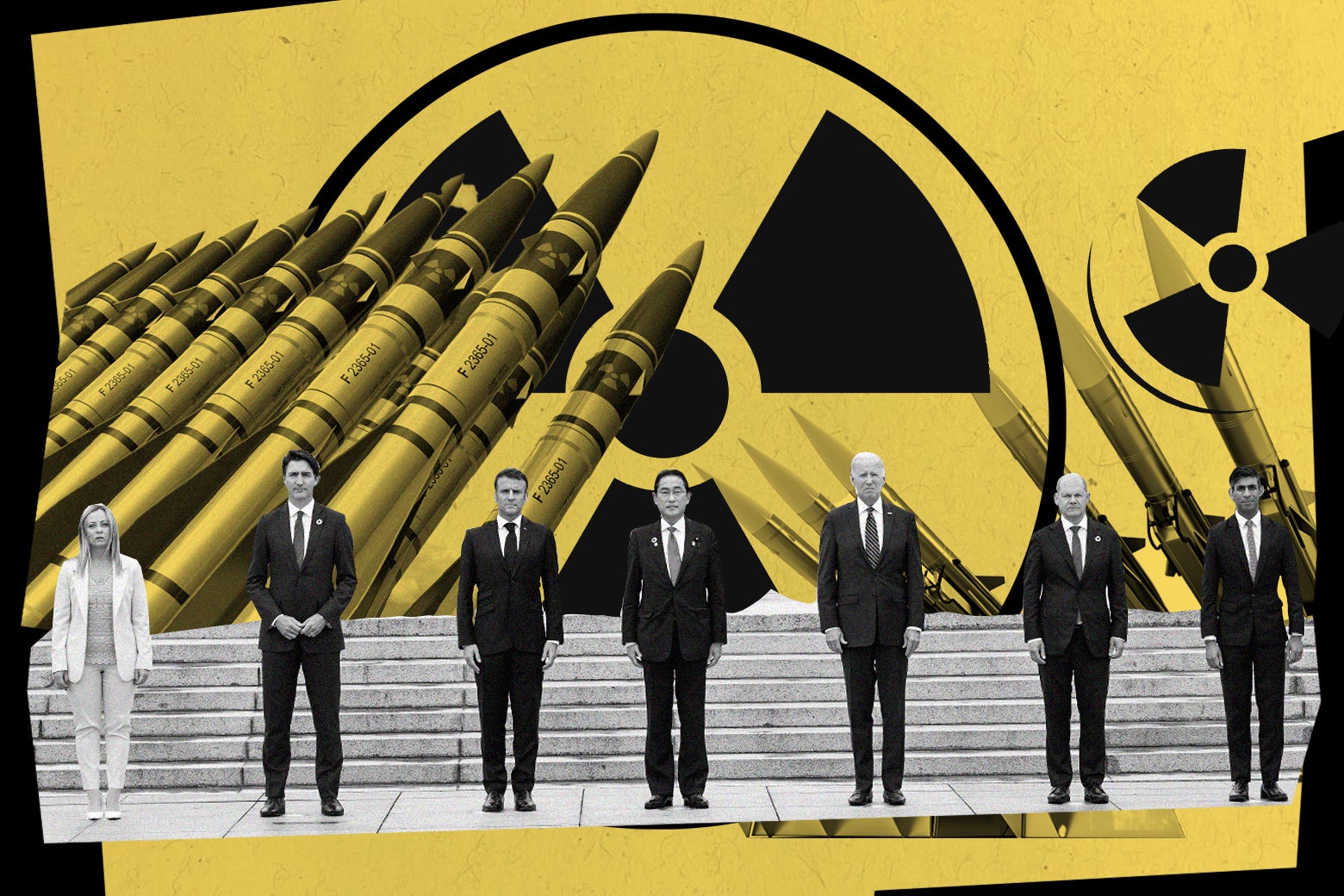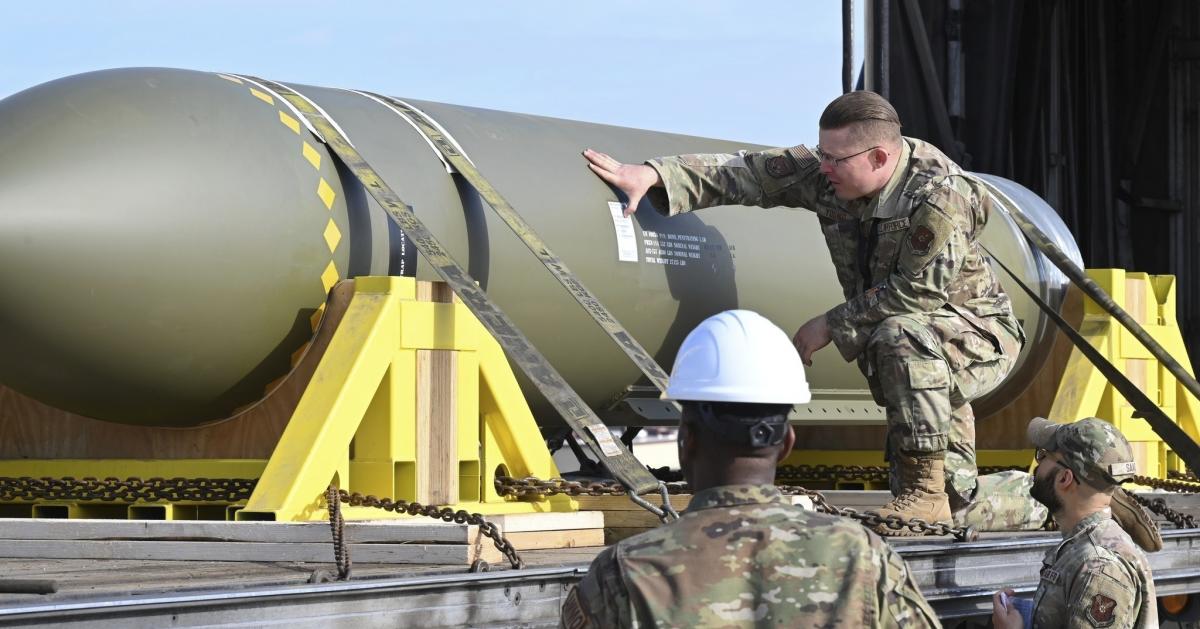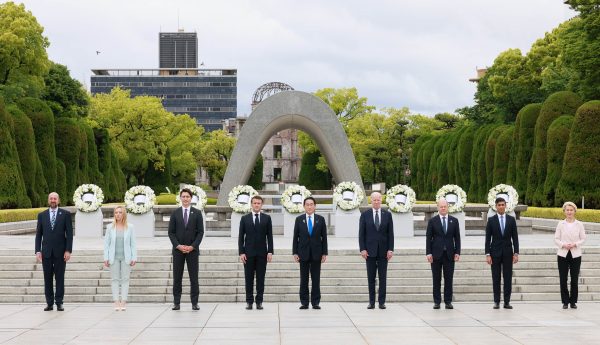(293) 04-29-2023-to-05-05-2023__****THE****WINDS****of****WAR****
(294) 05-06-2023-to-05-12-2023__****THE****WINDS****of****WAR****
(295) 05-13-2023-to-05-19-2023__****THE****WINDS****of****WAR****___________________________________________________________
Hummmm.............
Posted for fair use.....

The Alarming Reality of a Coming Nuclear Arms Race
Here's hoping we don't end up in an escalating nuclear arms spiral!
WAR STORIES
The Alarming Reality of a Coming Nuclear Arms Race
Japan told world leaders to work for “a world without nuclear weapons” at the G7—but the tide is turning in the opposite direction.
BY FRED KAPLANMAY 20, 2023 5:50 AM
Japanese Prime Minister Fumio Kishida decided to hold this weekend’s G7 meeting in Hiroshima—the first city destroyed by an atom bomb at the end of World War II—as a way of urging his fellow leaders to work for “a world without nuclear weapons.” Now, he said, “is the moment we must insist on the need to revitalize … nuclear disarmament.”
His colleagues— the leaders of the U.S., Britain, Canada, Germany, France, and Italy—will no doubt take a moment to bow their heads and mourn the tragedy of the past, then return to the summit’s real agenda: tightening sanctions on Russia, upping the arming of Ukraine, and figuring out how to deal with China.
The fact is, the world is less disposed to nuclear arms control than at any time in the last half-century—and the pressures for a renewed nuclear arms race, this time involving more than just two players, are disturbingly intense.
The pattern is clear: Russia has dropped out of the forum that monitors compliance with the New START arms-reduction treaty, which Presidents Joe Biden and Vladimir Putin extended just two years ago. Both the United States and Russia are developing new versions of all their nuclear-tipped armaments—land-based intercontinental ballistic missiles, submarine-launched ballistic missiles, long-range bombers, cruise missiles, and more. China seems on a course to achieve parity with the two larger powers, tripling the number of its nuclear warheads over the next decade. North Korea keeps churning out more A-bombs and testing new missiles. Iran creeps closer to a weapons-grade enrichment of uranium. South Korean leaders openly talk about possibly building an atomic arsenal too; officers in other technically advanced countries whisper about it behind closed doors.
Why are these pressures intensifying now?
The demonstrable fact is, if a country has nuclear weapons, it’s less likely to be attacked. That’s what “nuclear deterrence” is about: “If you nuke me, I’ll nuke you.” And it’s not just nuclear attacks that are deterred. “Even if you just attack me with conventional weapons, I might respond by nuking you.”
This, of course, is why the U.S. and its NATO allies haven’t directly intervened in the Ukraine war. If they’d done so, Ukraine’s army would likely be pushing toward, or perhaps beyond, the Russian border. But Putin has threatened to use nukes if he faces an existential threat. Maybe he’s bluffing, but it would be irresponsible to bet the house that he is.
All of the presidents, prime ministers, and tyrants plowing their way toward possible nuclear arsenals—or enlarging their real, existing arsenals—have reasons for doing so. They may be unsound or illogical reasons. But they are based on real fears, which leave open plenty of doors for certain advisers in their midst to make the case that nukes will solve their problems.
North Korea is the most obvious case. Kim Jong-un has nothing going for him but nuclear weapons. His country is impoverished. It has no natural resources. Like his two predecessors in the Kim dynasty, he feels surrounded by enemies (“a shrimp among whales,” as his grandfather, Kim il-sung, put it). His father, Kim Jong-il, developed nukes not only as deterrents but as bargaining chips to extract economic aid. The current leader, seeing that tactic’s limits, accelerated the program—as a deterrent for its own sake, and perhaps as back-up for threats of aggression. He is also confident that his one real ally, China, will let him do so because the threat keeps U.S. air and naval forces bottled up in northeast Asia and thus less able to concentrate their firepower near Beijing’s areas of interest along the Taiwan Strait and the South China Sea.
South Korea’s nuclear contemplations were sparked by North Korea’s real program—and by fears that the United States might welch on its longstanding promise to come to Seoul’s aid in the event of armed aggression. When Donald Trump was president, he openly said he might end this commitment. Just this past April, President Joe Biden struck a deal to involve South Koreans in U.S. military planning—including nuclear planning—if they stopped talking about going nuclear themselves. But Trump or someone like him may ascend to the White House again, and so the mulling won’t cease entirely.
Iran played the bargaining-chip game. In 2015, along with six other nations, it signed an accord in which Iran dismantled most of its nuclear program—essentially closing off all paths to a nuclear weapon—and the other countries lifted an array of economic sanctions, thus permitting it to join the world economy. The verification clauses were very tight; international inspectors attested several times that Iran was complying with the deal. Then, in 2018, President Donald Trump abrogated the accord, re-imposed sanctions, and forced the other countries to re-impose sanctions as well.
The results were twofold. First, after a year of seeking some way around the blockade, Iran restarted its nuclear program. Second, and more broadly, Iran and other countries—especially those led by tyrants—are suspicious of making any sort of deal with the U.S., knowing that some future president might simply step out of it. This very much includes North Korea.
Kim, the mullahs of Tehran, and others mulling the nuclear option certainly recall as well the fate of Libya’s Muammar Gaddafi, who agreed to give up his nascent nuclear-weapons program and wound up dead at the hands of rebels who were aided by NATO air strikes. (The rebellion, which rose up as a proper reaction to a campaign of murderous cruelty against his own people, took place eight years after he dismantled his nuclear program, but other tyrants took note: in the interim, he got nothing in exchange for dismantling his program.)
What about the larger powers—the U.S. and Russia, with their 1,500 nuclear warheads each, plus stockpiles of more in reserve? What have they got to worry about?
The U.S. is developing new weapons mainly because its existing missiles, planes, and submarines are getting old. Actually, only a few of them are verging on obsolescence; most could be modified for many more years. (Minuteman ICBMs, a half-century old, still work fine; ditto for B-52 bombers whose airframes are older still.) But even if some new models are needed, do we need them in the same number? For instance, do we need 400 ICBMs, given the many hundred missiles on submarines that can attack the same targets and do so from underwater positions that can’t be detected or preemptively attacked? No one has made the case that we do; more appalling, almost no one in Congress, or even in the think-tank world, has asked officials to make the case. It has come down to theatrics: Russia and China are building new weapons—in some cases, more weapons (which the U.S. is not doing)—so we have to do so, too, at a cost of roughly $50 billion a year. Nobody in a position of power is contesting this.
Why is Russia playing this game? Mainly because Putin is getting desperate. Well into the 1970s, the United States had thousands—at one point, as many as 7,000—nuclear weapons in Western Europe. These included aerial bombs, short-range missiles, even nuclear artillery shells. They dated from a time when the Soviet Union and its Warsaw Pact allies far outnumbered the U.S. and NATO in conventional troops and weapons. Nukes were seen as a way of compensating for this inferiority—both to deter an invasion and to counter an invasion if it actually occurred. (We’ve dismantled all but 100 or so of these weapons, all of them aerial bombs.)
Today the situation is reversed: The U.S. and NATO hold an edge over Russia in conventional arms, and Russia is compensating by retaining—and “modernizing”—a large nuclear arsenal to use on the battlefield. The idea is even crazier now than it was a half century ago: Europe is so densely populated that the “smallest” nuclear weapon would kill lots of civilians and would prompt retaliation, and likely escalation. Russia could not “win” in any meaningful sense.
Russia has therefore added a twist to this form of deterrence—a strategy called “escalate to de-escalate.” The idea is this: If NATO is winning a conventional war, Russia would launch a few tactical nuclear weapons—not for any specific military purpose, but to shock Western leaders into ending the war, before it reels out of control. Is this threat plausible? Yes. (See the war in Ukraine.) The U.S. has built “low-yield” nuclear weapons (about 8 kilotons in explosive power, two-thirds the explosive yield of the Hiroshima bomb), so that we could “retaliate In kind” to Russia’s peculiar escalation. Is this threat plausible? Who knows?
The point is, there is a logic to the U.S. and Russian impulses to build new types of nuclear weapons—though it has an insane premise. It would require a politically secure and sage leader to step out of the rabbit hole, point out that it leads only to catastrophe, and do something to snap both sides out of the race.
Biden has shown in the past that he understands the insanity of a nuclear arms race—and of much about “nuclear strategy.” But there is no way for him and Putin to come to a meeting of minds on this right now; there is really no way for him to do so, even with the U.S. Congress. So we are stuck here for a while, and can only hope that Putin doesn’t get too desperate—and that our luck (by which I mean the whole world’s luck in staving off nuclear catastrophe for the past 78 years) holds for a little longer.
China is a somewhat different matter. Beijing built its first atom bombs in the mid-1960s and has never deployed more than a few hundred of them. This is because it has followed a policy of “minimal deterrence”—the idea that you build enough nukes so that, if a foe strikes you with nuclear weapons, you can strike back with enough force to devastate his country. This can be done with a few hundred nukes. (Britain and France, which have independent nuclear arsenals, long ago came to this same conclusion. Israel has about 200 nukes, though it has never officially acknowledged this.)
Now, though, something has changed: China has dug a lot of ICBM silos and may well soon fill them with ICBMs. It’s also producing these missiles. At the current rate, its arsenal of 400 nuclear warheads will rise to 1,500 by 2035. Why?
First, Xi Jinping wants to be a global power by around that time, and 1,500 would put him at parity with the U.S. and Russia. This is silly symbolism—though one could ask why he feels the need to waste money in the same way that Americans and Russia waste money. Still, he has learned that nukes are a tangible token of power, so here he goes.
Second, Xi has detected real shifts in the balance of power. CNA, a Virginia-based military research center, recently published a paper analyzing official Chinese writings on nuclear strategy. The paper concludes that, in recently years, China has taken note of new U.S. non-nuclear weapons that can do things that only nukes could do in the past. For example, “smart bombs,” even if armed with conventional explosives, are so accurate that they could disable or destroy blast-hardened missile sites. (In the old days, only the high blast of a nuclear bomb could do this.) A cyber strike could sever the communication links between a Chinese commander and his nuclear weapons, making it impossible to launch them. Missile-defense systems could shoot down Chinese nukes as they approach their targets.
All these advances could drastically degrade China’s ability to retaliate against a U.S. first strike—in other words, they could drastically degrade China’s ability to deter a U.S. first strike. Therefore, Xi (or someone in his entourage) calculates that China needs more nukes to maintain its second-strike capability.
Some of these fears are exaggerated. Most U.S. smart bombs don’t have the range to hit Chinese nuclear forces, even if launched near the coast. Cyber strikes against nuclear launch centers are, at least as far as we know, a bit hypothetical. Missile defenses don’t work all that well against long-range ballistic missiles.
Still, leaders tend to plan against worst-case scenarios, especially if the political climate is tense—and U.S.-Chinese relations are particularly tense. Even if they warm up, as seems to be the case, the military’s planning, which the tensions helped galvanize into being, would probably continue.




:quality(70)/cloudfront-us-east-1.images.arcpublishing.com/archetype/FBLXOFQVM5EKRP4ZBFEXNJNUYI.jpg)

/cloudfront-us-east-2.images.arcpublishing.com/reuters/62UUYLQEQVNKRPV5HSZWMFZUKY.jpg)




